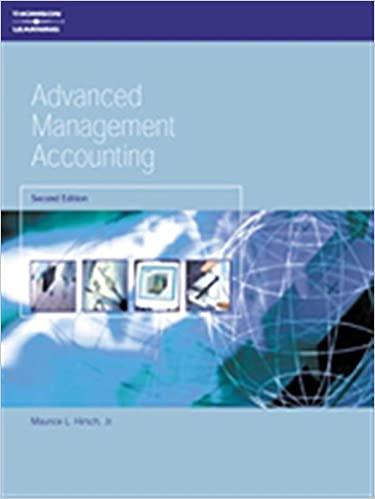Answered step by step
Verified Expert Solution
Question
1 Approved Answer
Milo-Freeze Company manufactures and sells a product that has seasonal variations in demand, with peak sales coming in the third quarter. The following information concerns
Milo-Freeze Company manufactures and sells a product that has seasonal variations in demand, with peak sales coming in the third quarter. The following information concerns operations for Year 2- the coming year- and for the first two quarters of Year 3:
- The companys single product sells for $10 per unit. Budgeted sales in units for the next six quarters are as follows:
| Year 2 Quarter | Year 3 Quarter | |||||
| 1 | 2 | 3 | 4 | 1 | 2 | |
| Budgeted unit sales | 40,000 | 60,000 | 100,000 | 50,000 | 70,000 | 80,000 |
- Sales are collected in the following pattern: 75% in the quarter the sales are made, and the remaining 25% in the following quarter. On January 1, Year 2, the companys balance sheet showed $65,000 in accounts receivable, all of which will be collected by the end of first quarter. Bad debts are negligible and can be ignored.
- The company desires an ending inventory of finished units on hand at the end of each quarter equal to 30% of the budgeted sales for the next quarter. On December 31, Year 1, the company had 12,000 units on hand.
-
- Six pounds of raw materials are required to complete one unit of product. The company requires an ending inventory of raw materials on hand at the end of each quarter equal to 10% of the production needs of the following quarter. On December 31, Year 1, the company had 23,000 pounds of raw materials on hand.
- The raw material costs $0.80 per pound. Purchases of raw material are paid for in the following pattern: 60% paid in the quarter the purchases are made, and the remaining 40% paid in the following quarter. On January 1, Year 2, the companys balance sheet showed $81,500 in accounts payable for raw material purchases, all of which will be paid for in the first quarter of the year
- PREPARE BUDGETS/SCHEDULES:
- sales budget.
- cash collections budget.
- production budget.
-
Assumption 0% Desired Ending Inventory - Starting inventory first quarter - Desired Ending Inventory 4th qtr Budgeted Sales Add Desired ending inventory of finished goods Total Needs Less beginning inventory of finished goods Required production - direct materials budget.
-
Required production in units of finished goods (from production report) Units of raw materials needed per unit of finished goods Production needs (units) Add Desired units of ending inventory of raw materials Total units of raw materials needed Less units of beginning inventories of raw materials Units of raw materials to be purchased Unit cost of raw materials Cost of raw materials to be purchased -
Percentage of purchases paid for in the period of the purchase 0% Percentage of purchases paid for in the period after the purchase 0% -
Assumption 0% Desired ending inventory RM 0 Pounds of Material per unit 0 Cost per unit $0 Beginning AP - Beginning RM - Desired ending inventory for 4th quarter - Cash payments for purchases of materials schedule
-
Percentage of purchases paid for in the period of the purchase Percentage of purchases paid for in the period after the purchase Schedule of expected cash distribution for materials Accounts payable, beginning Balance First quarter purchases Second quarter sales Third quarter sales Fourth quarter sales Total cash disbursements for materials
Step by Step Solution
There are 3 Steps involved in it
Step: 1

Get Instant Access to Expert-Tailored Solutions
See step-by-step solutions with expert insights and AI powered tools for academic success
Step: 2

Step: 3

Ace Your Homework with AI
Get the answers you need in no time with our AI-driven, step-by-step assistance
Get Started


